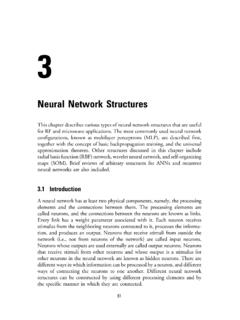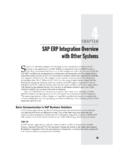Transcription of E-Commerce Systems Technology Infrastructure - …
1 2316E- commerce Systems Technology InfrastructureEarlier chapters discussed vital components of E-Commerce Systems . This chap-ter introduces the readers to ancillary Technology elements that an organizationrequires for the effective development and deployment of those Systems . Thedistributed nature of E-Commerce Systems has further necessitated develop-ments and innovations in technologies that bind the various components ofthese Systems together as a functioning unit. Middleware is one of those com-ponents that offer ancillary services such as security, transaction processing,time services, and so on for the building of complex E-Commerce Systems . Thedesign of E-Commerce Systems requires many middleware services, each ofwhich fulfills a unique role for the effective functioning of an E-Commerce sys-tem.
2 This chapter elaborates upon the many services that fall into the realm ofmiddleware. Directory services is another such component that enables systemsand users to locate each other on the network. Various standards and productsin this arena have challenged organizations to choose the right standard orproduct for their applications and business processes. This chapter presents anoverview of the popular directory services commonly used in the developmentand deployment of E-Commerce Systems . A groupware Technology Infrastructure is the cornerstone behind theestablishment of virtual communities and the enabling of E-Commerce applica-tions with features that enhance communication, collaboration, and informa-tion sharing. Groupware includes features such as e-mail, information sharingover the Internet and intranets, and workflow.
3 This chapter elaborates upontheir role within E-Commerce Systems . The multiple components and modules that shape an E-Commerce systemcoupled with the dynamic business requirements necessitates component andobject models for analysis and software development. The object-oriented stan-232E- commerce Systems Architecture and Applicationsdards and frameworks facilitate such development. This chapter delineatessome of those models and development paradigms. Systems MiddlewareMiddleware encompasses various technologies and products that facilitate theavailability of backend network resources ( , databases) for frontend applica-tions. Middleware components also include software that triggers backendapplications to achieve end-to-end automation of business processes ( , chain-ing the order-entry business process with inventory and distribution processes).
4 Middleware technologies facilitate integration with backend enterprise servicesthat range from simple cases of information repositories to complex ERP appli-cations ( , SAP R/3, Peoplesoft). An example in this case would be an e-com-merce based ordering system that interfaces with a production schedulingsystem that, in turn, ties-in to inventory, distribution, and shipping definitions exist for middleware. The IT industry has failed tostandardize on the specific terms regarding middleware. The only definitionthat the industry tends to agree upon is that middleware is anything thatresides between the client (user) and the server (database and applicationresources). These components could be data access components, communica-tion protocols, specialized servers, or a mix of all of the above.
5 The on-goingevolution of computing architectures is one of the reasons for the ambiguousdefinition of middleware. Middleware played different roles in the three com-puting paradigms of legacy, client/server, and Internet-based computing. Trans-action processing (TP) monitors were the primary middleware Technology forlegacy applications. The client/server era introduced multiple versions of mid-dleware that included everything that resided between the two layers of the cli-ent and the server. Furthermore, a broader definition surfaced in the Internetera due to the vast distributed nature of Internet applications. This book categorizes middleware as all the software components andapplications that reside between the user (connecting through informationappliance applications that solicit input from users) and the backend servicerepositories.
6 These include access gateways, TP monitors, and other similarsoftware. For example, if a user requests fulfillment of an E-Commerce servicethrough an information appliance, all software that resides between an infor-mation appliance ( , a PC) and the backend applications falls within therealm of middleware. Middleware from the mainframe era primarily focused on the availabilityof backend resources. Middleware products such as transaction processing soft- E-Commerce Systems Technology Infrastructure233ware fit that description of middleware. The business application was a hodge-podge of business logic, network and database interfaces, and other applicationservices. Only transaction processing software resided outside the realm of thebusiness application to provide controlled access to databases.
7 The dawn of client/server computing triggered the emergence of addi-tional middleware technologies. These include various database and networkinterfaces to link the various client and server pieces. This is where the defini-tion of middleware started to blur. Distributed client/server computingresulted in additional middleware technologies and computing added more technologies and services to themiddleware category. The primary reasons for this were the increase in thenumber of tiers that fall between the information appliances and the backendservices and applications. Another reason was that the increase in the numberof clients in E-Commerce computing and the distribution of backend servicesacross various networks required specialized network and application popularity of building modular programs had decoupled these servicesfrom application programs and pushed them to the middleware these trends, middleware has come to encompass various products,technologies, and services, some of which include: Access gateways; Database interfaces; Network and communication interfaces; Application interfaces to facilitate interoperability between distributedapplications; Network/application services ( , security services, directory services,transaction services); Computer telephony integration (CTI) software.
8 Middle-tier business logic implemented using traditional softwaretechnologies and programming languages or object frameworks suchas Enterprise Java Beans (EJBs); Application execution services such as those that support large numbersof users, fault tolerance, workload balancing, session and state manage-ment, multithreading, accessing multiple resources, and others. As mentioned earlier, middleware technologies and services play a vitalrole in E-Commerce computing as they integrate a greater number of tiers in234E- commerce Systems Architecture and Applicationsorder to materialize an E-Commerce system . Middleware, for example, providesthe following services to E-Commerce Systems : It supports diverse client-side environments such as Java clients,ActiveX clients, and other graphical environments.
9 The decoupling of business logic from underlying application serviceshosted by different tiers requires new middleware technologies and ser-vices. Common Object Request Broker Architecture (CORBA) is anexample of a framework that defines such services. By integrating applications and data distributed throughout the Inter-net, middleware enables a variety of IT-enabled services and productsto customers. Organizations thus can offer better and more robustcontent by delivering an integrated view of applications. It supports various types of information appliances It integrates various tiers of E-Commerce Systems . It manages complex transaction flows. It can cope with the diversity of platforms (legacy, ERP, and others)and databases. It incorporates better failure detection and recovery capabilities.
10 It handles an increased load of users. Thus middleware technologies and products in an E-Commerce frame-work enable the formation of business relationships through the integration ofapplications and services. The evaluation, selection, and acquisition of middle-ware is thus quite vital to build proper functioning E-Commerce Systems . Thefollowing describes the popular middleware frameworks. FrameworksMiddleware frameworks are standards-based frameworks that enable the devel-opment of various middleware services. The two most popular camps definingthese standards are Microsoft and the Object Management Group (OMG).The OMG defines various standards related to object and component technol-ogies. Microsoft is pushing its COM architecture, whereas OMG is spearhead-ing the CORBA initiative. This section reviews the two frameworks and theircapabilities.


